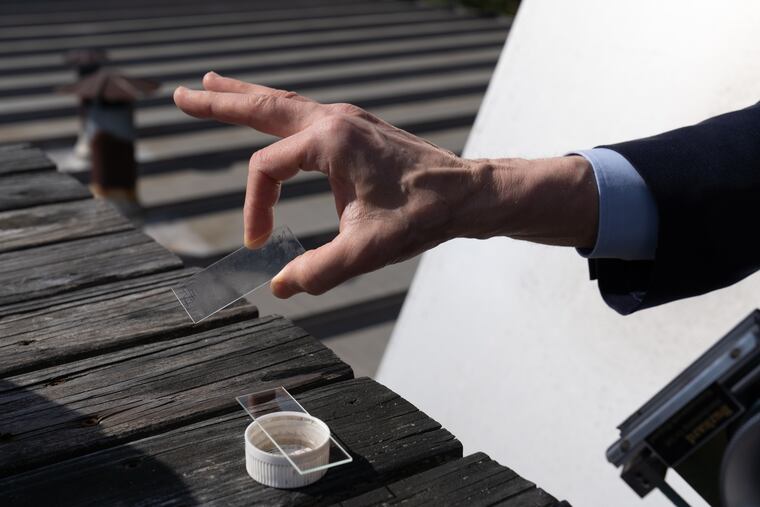‘I’ve never seen it that high’: Ragweed-pollen count flies off the charts in the Philly region
Ragweed counts were triple the "extreme levels" late last week, a pollen expert says. They likely will remain quite high this week, a downside of splendid weather.

The ragweed-pollen counts normally peak this time of year in the Philly region — but not quite like this.
The counts were “extreme” on Monday after reaching unprecedented levels last week, said Donald Dvorin, an allergist who practices in Mount Laurel and is the area’s only National Allergy Bureau pollen counter.
“I’ve never seen it that high,” said Dvorin, who has been doing this for 30 years. On Thursday, his pollen trap captured levels that were triple the extreme threshold.
And while the forecast is calling for a run of remarkably splendid days in the region, that might well be the equivalent of a storm warning for allergy sufferers. While Dvorin’s counts backed off considerably on Tuesday — something he expected, given how otherworldly they had been — he said conditions should be ideal for pollen flight into the weekend.
» READ MORE: Pollen has been used to solve crimes
Dvorin said the harvest is somewhat puzzling in that he hasn’t noticed much difference in this year’s variant of those perennially hardy crops. He suspects it has something to do with the decent rains earlier in the summer that were followed by heat and dryness in mid-July and August.
Whatever is behind the outburst, for some people ragweed is more than just a source of sneezing and coughing that induces a certain helium-brain sensation. The Allergy Foundation of America, which on Wednesday ranked Philadelphia among the 10 “most challenging” cities for asthmatics, identifies ragweed as a primary trigger for asthma attacks.
About ragweed
Ragweed doesn’t rate highly in plant charisma, but it certainly does reproduce, and pollen emissions are the key to that process.
Ragweed obviously doesn’t require cultivation. It is virtually ubiquitous. If you truly hate it, consider moving to Alaska, the only state in which it doesn’t grow, according to the allergy foundation.
The American Academy of Allergy, Asthma & Immunology says the most significant tormentor is the tooth-leaved ragweed that resides low in grasses. But Marc Goldstein, allergist at the Asthma Center in Philadelphia, has observed that it comes in 50 species and that a single plant can manufacture a billion pollen grains.
Dvorin said that to raise the volume of pollen in the air, “that’s all you need, one plant being proficient.”
The 2022 season
This year’s season has at least one thing in common with others he’s experienced, Dvorin said: It’s been full of surprises. “Every year something different happens,” he said.
His counts did not reach extreme levels at any point during the last two seasons. Nor did they register as extreme in the last two years in the daily counts provided by the Asthma Center in Center City, which uses a machine-learning technology.
Dvorin noted that the counts were suppressed on Sept. 8, not surprising given that it was pouring rain, which puts the damper on pollen flight. He suspects that on Thursday, the plants were ready to make up for lost time and were ready to party.
He doesn’t expect counts to return to those levels, but they very likely will remain above or near the extreme category.
The season typically extends through September and creeps into October.
The future of pollen
While predicting pollen levels year-to-year for now isn’t possible, Dvorin said, some evidence suggests the seasons are getting longer. That would be tied to generally warmer falls, in turn tied to worldwide warming.
An Inquirer analysis found that from 2001 through 2018, Philadelphia’s first official freeze — defined as the first day that the temperature dropped to 32 degrees — on average was arriving on Nov. 14, six days later than it was in the period from 1874 to 2000.
“We do know that the ragweed season keeps extending due to warmer temperatures from climate change,” said Melanie Carver, chief mission officer of the Asthma Foundation.
Unfortunately ground- and air-truth data are wanting, Dvorin said, as for a variety of reasons fewer allergists are participating in the counting network.
» READ MORE: Pollen unfortunately is poorly measured in America
Keeping score
Allergists recommend shots and medications and also the obvious: Avoid pollen.
If you do spend time outside, change your clothes when you go back inside, and keep the windows closed if possible.
» READ MORE: Masks can filter pollen, but they can be ‘double-edged swords’
Keep an eye on the daily counts, keeping in mind that they are snapshots, and aren’t predictive.
Center City’s Asthma Center posts real-time counts around daybreak, and Dvorin’s counts, which are based on a 24-hour sample of what has been captured in his pollen trap, usually are available in the afternoon.
Ragweed and COVID
While ragweed is considered an asthma trigger, it has nothing do with COVID-19.
Allergy and COVID-19 symptoms can overlap, doctors advise, among them coughing, fatigue, headache, and a loss of smell.
However, allergies are not associated with fevers, chills, sore throats, muscle pain, or intestinal problems.
Here is an Asthma Center chart summarizing the differences: